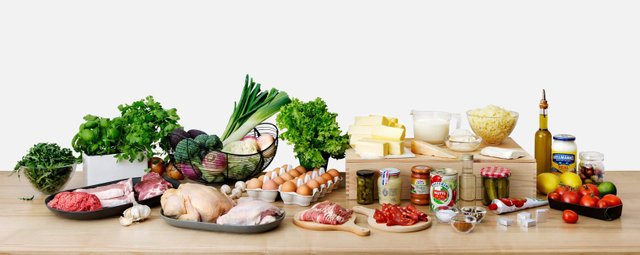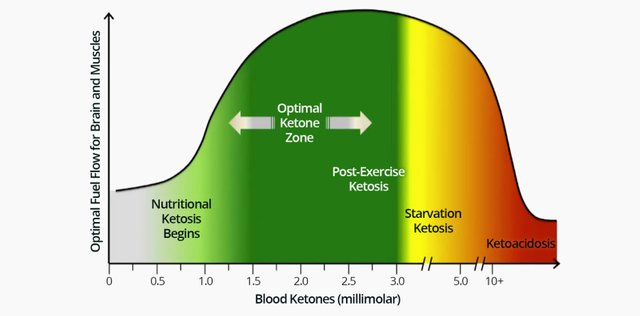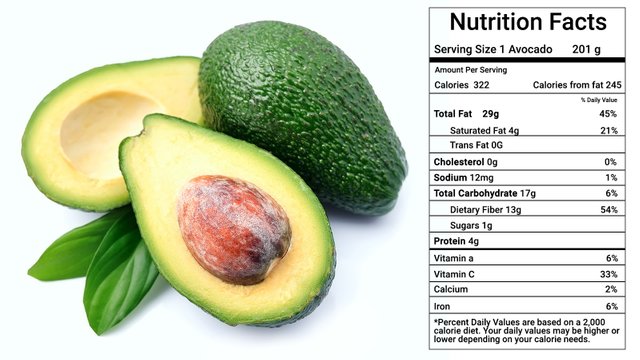Ketogenic Caloric Profile

The Ketogenic Diet
The Ketogenic Diet is low in carbohydrate and high in fat—LCHF. To my knowledge, there is still no clinical definition of what constitutes LCHF, but the following caloric profile is a sensible guide. Note that these figures refer to the percentages of the calories or kilojoules (ie energy) in the food: they do not refer to the mass (or weight) of the food. Typically, 1 g of fat provides about 9 kcal or 38 kJ of energy, whereas 1 g of carbohydrate and 1 g of protein each provides only about 5 kcal or 21 kJ.
| Fats | Carbohydrates | Protein |
|---|---|---|
| > 60% | < 10% | < 30% |
75-80% fat, 5% carbs and 15-20% protein is a good target to aim for. Several sources I consulted also claim that if you consume no more than 50 g of net carbs per day, you will achieve ketosis and quickly become keto-adapted, while some enthusiasts restrict their daily net carbs to just 20 g per day.
Net carbs is an important concept in the Ketogenic Diet, but defining precisely what a net carb is is far from trivial. Loosely speaking, net carbs are carbohydrates that have calories in them, such as sugars and starch, or carbohydrates that raise your blood sugar levels or your insulin levels. This is a subject to which I will return after I have researched it some more. For the time being, however, if you restrict your daily intake of sugars and starch to no more than 50 g, you are probably safe.
Keto-Adaptation, you may remember, is the metabolic state in which your body is using fat rather than glucose as its primary source of energy, and your liver is producing ketone bodies. These ketones, which are derived from fatty acids, are primarily used to fuel your brain. In the initial stages of keto-adaptation, when your body is still becoming adapted, your skeletal muscles also metabolize ketones for energy. But in time, as the body becomes better adapted to the new regime, your muscles will be weaned off the ketones and will come to rely on free fatty acids for most of their energy—even when you are running a Marathon (Volek & Phinney 2011:164). The ketones will be reserved for your brain and other organs that cannot metabolize free fatty acids.

Ketosis—the metabolic state in which your liver is producing ketones—is loosely defined as the state in which the concentration of one of the three ketone bodies, beta-hydroxybutyrate or BHB, exceeds 0.5 mmol per litre of blood. The range of 0.5–3.0 mmol L-1 is characterized as nutritional ketosis. Long-term starvation or the complete elimination of carbohydrates from the diet is generally required to exceed 3.0 mmol L-1 and enter what is called therapeutic ketosis.
The question, then, is: How do I ensure that the food I am consuming has a ketogenic caloric profile?
The short answer is: educate yourself.
If you are serious about your new diet, you should take the trouble to learn a little about the science of nutrition. You must become adept at reading and understanding the lists of ingredients and the nutritional labels that accompany most foodstuffs.

This is something we will look at in greater detail in a later article, but broadly speaking, you will soon learn that foods can be distributed into four classes as far as the Ketogenic Diet and caloric profiles are concerned:
Ketogenic Foods: These are foods whose caloric profile is ketogenic. These are the staples of the Ketogenic Diet.
Lo-Carb Foods: These are foods whose caloric profile is not ketogenic but which are low in net carbs (say, less than 5 g of net carbs per 100 g of food). You can, therefore, consume plenty of these without going over your daily net carb limit. Lo-Carb foods can form a regular part of your diet when accompanied by ketogenic foods, which will provide the necessary fat.
Medium-Carb Foods: These are foods whose caloric profile is not ketogenic, and which contain moderate amounts of net carbs (roughly 5-15 g per 100 g). You can consume these in moderation without going over your daily net carb limit.
Hi-Carb Foods: These are foods whose caloric profile is not ketogenic, and which are high in net carbs (greater than 15 g per 100 g). You can still consume small amounts of these infrequently provided you “dilute” them with appropriate LCHF foods. But many of these foods are so high in net carbs that the safest approach is to simply cut them out of your diet completely.
Here are some examples of these four broad classes of foods:
| Keto | Lo-Carb | Medium-Carb | Hi-Carb |
|---|---|---|---|
| Fats | Spinach | Strawberries | Cereals |
| Oils | Kale | Raspberries | Grains |
| Nuts | Cabbage | Blueberries | Potatoes |
| Seeds | Cauliflower | Blackberries | Sweets |
| Eggs | Lettuce | Cranberries | Candy |
| Cheeses | Asparagus | Carrots | Honey |
| Creams | Brussels Sprouts | Onions | Mangoes |
| Pepperoni | Artichokes | Loganberries | Apples |
| Salami | Broccoli | Gooseberry | Oranges |
| Chorizo | Celery | Mulberries | Bananas |
| Peanuts | Cucumber | Boysenberries | Cherries |
| Nut Butters | Jicama | Blackcurrants | Dates |
| Tahini | Mushrooms | Redcurrants | Dried Fruit |
| Avocados | Radishes | Jostaberries | Grapes |
| Olives | Sauerkraut | Beetroot | Pineapple |
| Almond Flour | Plant Milks | Pumpkin | Plums |
| Coconut Flour | Spirits | Wine | Beer |
Some of the fruits I have included in the high-carb column are actually borderline medium-carb (eg oranges and plums), so you should educate yourself rather than simply take the advice of someone on the Internet.
As a general rule, however, I would advise you to give up the following foods (including gluten-free varieties):
- Breads
- Breakfast Cereals
- Cakes
- Buns
- Pastries
- Pizza
- Pasta
- Rice
- Corn
- Candy and Sweets
- Fruit, except for berries in moderation
- Legumes (peas and beans), except for peanuts and peanut butter
- Potatoes, Chips (French Fries), Crisps (Potato Chips)
- Beers, Lagers, Ales, Porters, Stouts, Ciders
- Milk
Milk is an oddity that requires some comment. With only 4-5 g of net carbs per 100 g, it qualifies as a lo-carb food. But 100 g of milk only amounts to about seven tablespoons—little more than a mouthful. A few cappuccinos can quickly exhaust your daily allowance of net carbs. The best option is to remove milk from your diet as much as you can and replace it with a plant milk (eg flax milk) or nut milk (eg almond milk). Contrast this with, say, garlic. There are approximately 30 g of net carbs in 100 g of raw garlic, so garlic is certainly hi-carb. But no one eats 100 g of garlic in a day. At most, you might consume three cloves. That’s about 9 g in total or less than 3 g of net carbs. So garlic is in, while milk is out.
The good news is that there are also keto substitutes for most of the other non-keto staples of the traditional Western diet. The Internet is replete with recipes for keto breads, granolas, pizzas, cakes, buns, desserts. You can even use lo-carb vegetables like jicama, radish, turnip, swede, zucchini and celeriac to make chips (French fries). Exploring this new world of culinary delights is one of the most exciting things about the Ketogenic Diet. I have never spent so much of my time in the kitchen trying out new recipes as I have since going keto.
Remember, also, that even hi-carb foods can be eaten on the Ketogenic Diet, provided they are only consumed in small quantities and are “diluted” with LCHF foods. There is nothing wrong with having a little treat now and again. The bottom line is: if I indulge in this little high-carb treat, will it knock me out of ketosis? If the answer is no, then it is generally safe to indulge—though, as we shall see in later articles, there are other very good reasons for abstaining totally from sugary treats. There’s such a thing as dirty keto.
But there is more to the Ketogenic Diet than simply eating meals that have the correct caloric profile and fewer than so many net carbs. In the next article in this series, we will take a look at the Ketogenic Diet’s fat profile—because not all fats are equal.
So there’s much to learn.
References
- Jeff S Volek, Stephen D Phinney, The Art and Science of Low Carbohydrate Living, Beyond Obesity LLC (2011)
- Jeff S Volek, Stephen D Phinney, The Art and Science of Low Carbohydrate Performance_, Beyond Obesity LLC (2012)
- Jacob Wilson, Ryan P Lowery, The Ketogenic Bible: The Authoritative Guide to Ketosis, Victory Belt Publishing, Las Vegas (2017)
Image Credits
- Ketogenic Foods: © Diet Doctor, Fair Use
- Glycolysis, Nutritional Ketosis and Therapeutic Ketosis: MyKetoKitchen, after Volek & Phinney, The Art and Science of Low Carb Living, Fair Use
- US Nutrition Label for Avocado: Copyright Unknown, Fair Use

People are slowly coming around to the fact that they need to consume less processed food and carbs...glad you spreading the word.
Regards @run.vince.run
Great post. It doesn't seem like you are getting the likes it deserves though. Have you checked out the upvote communities? You should check out steemengine. or steemfollower.com.